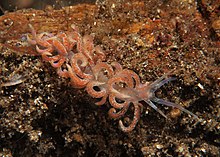| Phyllodesmium poindimiei | |
|---|---|

| |
| Scientific classification | |
| Domain: | Eukaryota |
| Kingdom: | Animalia |
| Phylum: | Mollusca |
| Class: | Gastropoda |
| Order: | Nudibranchia |
| Suborder: | Cladobranchia |
| Family: | Myrrhinidae |
| Genus: | Phyllodesmium |
| Species: | P. poindimiei |
| Binomial name | |
| Phyllodesmium poindimiei (Risbec, 1928) | |
| Synonyms | |
| |
Phyllodesmium poindimiei (AKA: Spun Of Light) is an Alcyonacea feeding, aeolid nudibranch Gastropod belonging to the family Facelinidae. Cerata are important in this clade in terms of their physical defense and efficient metabolic processes. This species is spread sporadically along tropical coastal regions such as Australia, Hawaii, and the Indo-Pacific living in diverse marine habitats such as coral reefs. Unlike other species in the Opisthobranch Mollusca clade, P. poindimiei’s lush pink cerata are used for defensive purposes other than Nematocyst (dinoflagellate) capture and toxin release. Organismal ties within these thriving, tropical ecosystems can be determinants of environment change, which affects massive coral ecosystems. Continuously changing marine ecosystems, such as coral reefs, are directly linked to the evolution of organisms that live and thrive in the tropics such as the soft nudibrach P. poindimiei.
Evolution and description

This monophyletic clade of mollusks were prosobranchs that eventually rid themselves of an exoskeleton. Elongated metazoans will lengthen themselves out to about 50 mm at longest. P. poindimiei typically has two pairs of tentacles with a built in olfactory system containing an eye at each base. The soft shell-less slug has cerata outgrowths on its upper side filled with the organism’s respiratory and digestive systems and can be cast off for protective purposes. These cylindrical gill cavities typically have two main defenses resulting from nematocyst or zooxanthellae obtainment. These translucent cerata for most Phyllodesmium contain cnidosacs at the tips in which nudibranchs digest nematocysts from Cnidarian prey, such as jellyfish or corals. P. poindimiei lack these cnidosacs that could be used for its own defense against the swimming crab Thalamita integer. Another modification this species lacks is the ability to accumulate zooxanthellae, microscopic photosynthetic dinoflagellates, in the branched digestive tract. The non-symbiotic species such as P. poindimiei were thought to have evolved earlier than the symbiotic clades.
Diet and growth
P. poindimiei live up to twelve months and develop from an egg to a free-swimming veliger larva. They feed on Telesto, Caridoa, and other Alcyonaceans with very small radula. Members of the Porifera phyla, sponges, act as epibiont on sediment or ectozoans on organisms, such as Octocorallia. Excess spongiform growth thereby prevents this Aeolid from consuming octocoral, a common prey for P. poindimiei which can become a problem for these picky eaters.
Ecology and conservation
Heterobranchs range from aquatic to terrestrial environments but P. poindimiei specifically tends to surround itself with other multicellular organisms in tropical sessile environments such as diverse coral reefs. Many of the tropical locations where P. poindimiei reside are climate change research biotopes. Environment change is ideally studied using these animals because of their prompt life span and revival linkage to a diverse habitat sensitive to oceanic temperature change that could potentially cause coral bleaching. Most species of Phyllodesmium are found along the coastline of Australia, Hawaii, and the Indo-Pacific regions. Coastal channels and estuaries allow for ample shelter for these marine gastropod nudibranchs.
References
- Risbec J. (1928). "Contribution á l'étude des nudibranches Néo-Calédoniens". Faune Colon. Fr. 2: 1-328.
- Bouchet, P. (2015). Phyllodesmium poindimiei. In: MolluscaBase (2015). Accessed through: World Register of Marine Species on 2015-10-07
- ^ Wägele H., Klussmann-Kolb A. (2005). "Opisthobranchia (Mollusca, Gastropoda) – more than just slimy slugs. Shell reduction and its implications on defence and foraging". Frontiers in Zoology. 2 (1). BioMed Central Ltd.: 3. doi:10.1186/1742-9994-2-3. PMC 554092. PMID 15715915.
- ^ Wagner, Daniel; Kahng, Samuel E.; Toonen, Robert J. (2009). "Observations on the life history and feeding ecology of a specialized nudibranch predator (Phyllodesmium poindimiei), with implications for biocontrol of an invasive octocoral (Carijoa riisei) in Hawaii". Journal of Experimental Marine Biology and Ecology. 372 (1–2): 64–74. doi:10.1016/j.jembe.2009.02.007.
- Wiggle H., & Klussmann-Kolb A. (2005). "Opisthobranchia (Mollusca, Gastropoda) – more than just slimy slugs. Shell reduction and its implications on defence and foraging". Frontiers in Zoology. 2 (1): 3. doi:10.1186/1742-9994-2-3. PMC 554092. PMID 15715915.
- ^ Goulet, T.L. (September 8, 2006). "Most corals may not change their symbionts". Marine Ecology Progress Series. 321: 1–7. Bibcode:2006MEPS..321....1G. doi:10.3354/meps321001.
- ^ Moore, Elizabeth J.; Gosliner, Terrence M. (2011). "Molecular phylogeny and evolution of symbiosis in a clade of Indopacific nudibranchs". Molecular Phylogenetics and Evolution. 58 (1): 116–123. doi:10.1016/j.ympev.2010.11.008. PMID 21094687.
- Thompson, T.E. (April 1977). "Biology of Opisthobranch Molluscs". Journal of Molluscan Studies. 43 (1): 207. doi:10.1093/oxfordjournals.mollus.a065362.
- Risbec, J (1928). Contribution á l'étude des nudibranches Néo-Calédoniens. Société d'éditions géographiques, maritimes et coloniales. Paris.
{{cite book}}:|website=ignored (help) - Greenwood, Paul G. (March 6, 2009). "Acquisition and Use of Nematocysts by Cnidarian Predators". Toxicon. 54 (8): 1065–1070. doi:10.1016/j.toxicon.2009.02.029. PMC 2783962. PMID 19269306.
- ^ Rudman W.B. (June 28, 2008). "The anatomy and biology of alcyonarian-feeding aeolid opisthobranch mollusks and their development of symbiosis with zooxanthellae". Zoological Journal of the Linnean Society. 72 (3): 219–262. doi:10.1111/j.1096-3642.1981.tb01571.x.
- Rützler, Klaus (March 15, 1970). "Spatial competition among porifera: Solution by epizoism". Oecologia. 5 (2): 85–95. Bibcode:1970Oecol...5...85R. doi:10.1007/BF00347624. PMID 28310351. S2CID 20608604.
- ^ Willan, R. C.; Dollimore, J. M.; Nicholson, Jon (1979). "A survey of fish populations at Karikari Peninsula, Northland, by scuba diving". New Zealand Journal of Marine and Freshwater Research. 13 (3): 447–458. doi:10.1080/00288330.1979.9515822.
- Beesley, P. L.; Ross, G. J.; Wells, A., eds. (1998). Mollusca: the southern synthesis. CSIRO.
External links
- Photos of Phyllodesmium poindimiei on Sealife Collection
| Taxon identifiers | |
|---|---|
| Phyllodesmium poindimiei | |